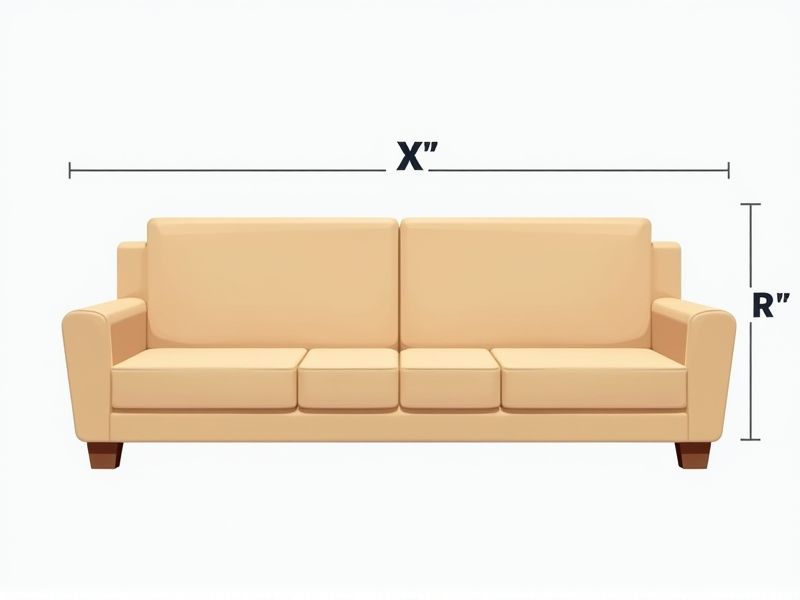
When choosing a sectional sofa, it's helpful to know the standard dimensions to ensure a great fit in your living space. Most sectional sofas typically range from 94 to 156 inches wide, with seat depths between 36 and 40 inches, providing ample seating and comfort. The length of each side can vary depending on the configuration, but common shapes like the L-shaped or U-shaped sectionals often extend 90 to 120 inches per side. Remember to allow for extra room around the sofa for easy movement and complementary furniture placement.
Corner Configuration
A corner configuration in a sectional sofa maximizes seating while fitting snugly into tight spaces, perfect for optimizing your living area. Typically, these sofas feature L-shape designs that offer versatility, making them suitable for both casual lounging and formal gatherings. Most corner sectionals range in size from 90 to 120 inches, accommodating various room dimensions and layouts. Look for features like removable cushions and built-in storage to enhance functionality and comfort in your chosen design.
Number Of Seats
When selecting a sectional sofa, the critical factor to consider is the number of seats it provides, which typically ranges from 5 to 10 seats based on the design and configuration. For spacious living areas, a large 9-seater can create a comfortable gathering space, accommodating family and guests. Conversely, a smaller 5-seater model is ideal for more intimate settings or compact apartments, maximizing space without sacrificing comfort. Choosing the right seating capacity not only enhances your living area's functionality but also complements your lifestyle and entertaining needs.
Depth Of Seat
When selecting a sectional sofa, a crucial measurement to consider is the seat depth, which typically ranges from 20 to 25 inches. A deeper seat, around 24 inches, offers enhanced comfort for lounging, while a shallower depth, close to 20 inches, can be more suitable for upright sitting and smaller spaces. This dimension not only affects the overall comfort but also influences how easily you can get in and out of the sofa. For optimal usage, ensure that the seat depth aligns with your personal preferences and the intended use of the sofa in your living area.
Length/Width Of Each Section
The standard sectional sofa typically measures around 130 to 150 inches in total length, providing ample seating for multiple individuals. Each sectional section can vary, with width dimensions ranging from 30 to 40 inches, allowing for comfortable lounging. It's crucial to consider your available space when selecting a sectional, ensuring that it fits well without overwhelming the room. By understanding the dimensions of individual sections, you can create a balanced layout that complements your interior design.
Backrest Height
The standard backrest height for sectional sofas typically ranges from 30 to 36 inches, providing optimal support for your lumbar spine. This height ensures that most adults can comfortably rest their back while maintaining an ergonomic posture. A backrest of this height is particularly beneficial for encouraging upright seating during prolonged use, making it ideal for living rooms or entertainment spaces. Your choice in backrest height can significantly influence the overall comfort and aesthetic appeal of the sectional sofa in your home.
Armrest Height
The standard armrest height for a sectional sofa typically ranges from 24 to 30 inches above the floor, offering optimal comfort and support for your arms. This height allows for a relaxed seating position, reducing strain on your shoulders and neck during extended periods of use. When selecting a sectional sofa, consider your body dimensions, as taller individuals may prefer a higher armrest for better ergonomics. Ensuring that the armrest height aligns with your needs can greatly enhance your overall lounging experience.
Modular Flexibility
Modular sectional sofas offer unparalleled flexibility, allowing you to customize your seating arrangement to fit your space perfectly. Typically composed of multiple pieces, these sofas can be reconfigured in various layouts, accommodating different room sizes and design preferences. With options ranging from 2 to 8 seat arrangements, you can create an inviting and functional living area that suits your lifestyle. Investing in a modular sectional also ensures longevity, as many models feature durable materials and easy-to-clean fabrics, enhancing your home's aesthetic while providing practical utility.
Material And Upholstery
High-quality sectional sofas typically utilize durable materials such as hardwood frames, which provide excellent structural integrity and longevity. The upholstery options range from rich leather to various synthetic fabrics, ensuring a broad selection to match your decor and lifestyle. For optimal comfort, look for high-density foam cushions, which can range from 1.8 to 2.5 pounds per cubic foot in density. The choice of fabric can impact maintenance; for example, performance fabrics resist stains and are easy to clean, making them ideal for households with children or pets.
Space Requirement
When selecting a sectional sofa, consider the spatial footprint, which typically ranges from 90 to 150 inches in length. Measure your designated area to ensure that the sofa comfortably fits without overwhelming the space. A well-chosen sectional can effectively optimize seating capacity, accommodating 5 to 10 people depending on configuration and size. Finally, take into account the layout and flow of your room, as a sectional can visually enhance or obstruct movement within the area.
Weight Capacity
The weight capacity of sectional sofas can vary significantly, with many models supporting between 400 to 1,200 pounds, depending on construction and materials used. High-quality sectionals typically feature robust frames made of hardwood or metal, which directly influences their durability and longevity. When selecting a sectional sofa, consider your specific needs, including the number of users and their average weight, to ensure optimal safety and comfort. By prioritizing weight capacity in your purchase, you can avoid potential damage and enhance the overall experience of your living space.
